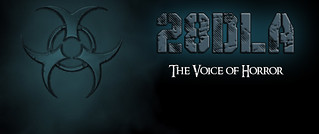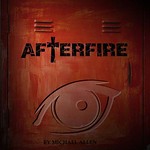*full disclosure: a DVD screener of this film was provided by Visual Entertainment Inc.
Director: Alfonso Gomez-Rejon.
Writers: Roberto Aguirre-Sacasa and Earl E. Smith.
Cast: Addison Timlin, Veronica Cartwright, Anthony Anderson and Travis Tope.
A new slasher is set to release this summer. The horror film is titled The Town that Dreaded Sundown. Astute horror film fans will realize that this is the second film to be based on the "Moonlight Murders." In 1946, a serial killer stalked the local lovers of Texarkana. He killed eight and assaulted several more. He was never caught. In the latest version of The Town that Dreaded Sundown, writer Roberto Aguirre-Sacasa ("American Horror Story") tries to bring some fictional closure to events, which took place over sixty-nine years ago. Though, the real life murders are more horrifying than the ones shown here. This latest film is an homage to the 1976 original film; but, it lacks any real terror.
Just as background, the Phantom Killer stalked several known romantic meeting places. He would target couples in the midst of a sexual embrace and he would intervene with a gun. Described by psychologists as a sadist, he would often kill both people and or rape the woman (sometimes with a Colt .32). His initial attacks were pulled off with less zeal, leading to the escape of Jimmy Hollis and Mary Jeanne Larey. He would quickly become more experienced and more bloodthirsty. Over the course of several weeks, he would kill eight people and attack a total of fifteen. His modus operandi would be repeated on backroads, until he shifted to farmhouses as the police and Texas Rangers closed in. It is believed that he moved onto another community, once the limelight became too bright.

Red lighting adds something here (allusion to blood).
The film develops somewhat differently. Jami (Addison Timlin) is the target of the film, throughout the runtime. The killer has a fascination with her, which diverges from the actual events. And, she must uncover the killer's identity, so that she can find safety and redemption, for her murdered boyfriend. In conjunction with the local law enforcement, she delves into the original 1946 murders, but finds few clues. She quickly overcomes the death of Corey (Spencer Treat Clark) at the killer's hand and finds new love. Meanwhile, couples are being killed in hotel rooms and in remote locations. A farmhouse stalk and chase series of linked scenes is the only sequence that shows any energy or offers any surprises. Even Jami manages to cruise through the film without much harm.
Simply, this latest film is an homage to the earlier 1976 version. Intertitles state that the film is taking place between Halloween and Christmas of 2013. Yet, the characters wear '70s garb and costumes. Phones and furniture look of this earlier era, also. So, the surface setting is more recent times, but the film's meta-setting is much further back. Also, director Alfonso Gomez-Rejon brings in several shots of the original film. A late night Drive-in shows the original film. And, Jami re-enacts scenes from the first film, while the Drive-in film plays. This is not an original film. Instead, this is mostly a replay of the first film, with some new sequences and characters added in, along the way. If you have seen the first film, you have seen much of what happens here, as well.
This reviewer was disappointed by several of the film elements. There is some symbolic imagery here. A film reel can be heard spinning as one character is killed. The reel is mimicked with a red, glowing taillight. As well, another film reel plays over a chase sequence. The director wants viewers to know that this is a film and this is a film that is mostly replaying the original. If that is not clear, signs state "remember," and "forgotten," to remind viewers of the terror brought to t e screen in 1976. Also, lighting added in some dramatic effect during a murder sequence. Bright reds smear across the screen. However, in later scenes, bright oranges and blues are less affective. Instead, they further link the film with the '70s and the garishness of this era. Finally, the director uses every camera trick in his book to make the screen appear interesting. The camera tilts left, then it tilts right. An overhead crane shot, during a farmhouse stalk and chase, looks interesting. But, the directing techniques rarely amplify any tension onscreen. Though, this critic enjoyed the close-ups of the killer's face. Viewers will see malevolence in his eyes. Outside of the costumes, there are only a few elements of creativity here.
The Town that Dreaded Sundown is a fairly average affair. The film is rewatchable, but it lacks any real tension. The killer does manage to strike at an inopportune time or two. Yet, the violence is muted, especially when compared to the actual events. In 1946, the victims were tortured and tormented. Here, the killer can only offer a glare, or a short chase down a forested trail. It would have been more interesting to have the film follow the real life events more closely. As it is, The Town that Dreaded Sundown (2014) steers clear of any unsettling material and this film will not stand out in the annals of film, nor put Texarkana on the map again.
Overall: 6 out of 10.
*this reviewer could not help but remember Dark Night of the Scarecrow (1981), while watching this film. The original 1976 film and Dark Night of the Scarecrow share settings and similarly dressed villains. The first film likely influenced the latter.
Some of the blood red lighting from the film can be seen in the trailer, at the .50-.59 mark:
The Town that Dreaded Sundown Trailer on 28DLA
Recommended release: Dark Night of the Scarecrow at Amazon
Subscribe to 28 Days Later: An Analysis 28 Days Later Analysis Email Subscription
Director: Alfonso Gomez-Rejon.
Writers: Roberto Aguirre-Sacasa and Earl E. Smith.
Cast: Addison Timlin, Veronica Cartwright, Anthony Anderson and Travis Tope.
A new slasher is set to release this summer. The horror film is titled The Town that Dreaded Sundown. Astute horror film fans will realize that this is the second film to be based on the "Moonlight Murders." In 1946, a serial killer stalked the local lovers of Texarkana. He killed eight and assaulted several more. He was never caught. In the latest version of The Town that Dreaded Sundown, writer Roberto Aguirre-Sacasa ("American Horror Story") tries to bring some fictional closure to events, which took place over sixty-nine years ago. Though, the real life murders are more horrifying than the ones shown here. This latest film is an homage to the 1976 original film; but, it lacks any real terror.
Just as background, the Phantom Killer stalked several known romantic meeting places. He would target couples in the midst of a sexual embrace and he would intervene with a gun. Described by psychologists as a sadist, he would often kill both people and or rape the woman (sometimes with a Colt .32). His initial attacks were pulled off with less zeal, leading to the escape of Jimmy Hollis and Mary Jeanne Larey. He would quickly become more experienced and more bloodthirsty. Over the course of several weeks, he would kill eight people and attack a total of fifteen. His modus operandi would be repeated on backroads, until he shifted to farmhouses as the police and Texas Rangers closed in. It is believed that he moved onto another community, once the limelight became too bright.

The film develops somewhat differently. Jami (Addison Timlin) is the target of the film, throughout the runtime. The killer has a fascination with her, which diverges from the actual events. And, she must uncover the killer's identity, so that she can find safety and redemption, for her murdered boyfriend. In conjunction with the local law enforcement, she delves into the original 1946 murders, but finds few clues. She quickly overcomes the death of Corey (Spencer Treat Clark) at the killer's hand and finds new love. Meanwhile, couples are being killed in hotel rooms and in remote locations. A farmhouse stalk and chase series of linked scenes is the only sequence that shows any energy or offers any surprises. Even Jami manages to cruise through the film without much harm.
Simply, this latest film is an homage to the earlier 1976 version. Intertitles state that the film is taking place between Halloween and Christmas of 2013. Yet, the characters wear '70s garb and costumes. Phones and furniture look of this earlier era, also. So, the surface setting is more recent times, but the film's meta-setting is much further back. Also, director Alfonso Gomez-Rejon brings in several shots of the original film. A late night Drive-in shows the original film. And, Jami re-enacts scenes from the first film, while the Drive-in film plays. This is not an original film. Instead, this is mostly a replay of the first film, with some new sequences and characters added in, along the way. If you have seen the first film, you have seen much of what happens here, as well.
This reviewer was disappointed by several of the film elements. There is some symbolic imagery here. A film reel can be heard spinning as one character is killed. The reel is mimicked with a red, glowing taillight. As well, another film reel plays over a chase sequence. The director wants viewers to know that this is a film and this is a film that is mostly replaying the original. If that is not clear, signs state "remember," and "forgotten," to remind viewers of the terror brought to t e screen in 1976. Also, lighting added in some dramatic effect during a murder sequence. Bright reds smear across the screen. However, in later scenes, bright oranges and blues are less affective. Instead, they further link the film with the '70s and the garishness of this era. Finally, the director uses every camera trick in his book to make the screen appear interesting. The camera tilts left, then it tilts right. An overhead crane shot, during a farmhouse stalk and chase, looks interesting. But, the directing techniques rarely amplify any tension onscreen. Though, this critic enjoyed the close-ups of the killer's face. Viewers will see malevolence in his eyes. Outside of the costumes, there are only a few elements of creativity here.
The Town that Dreaded Sundown is a fairly average affair. The film is rewatchable, but it lacks any real tension. The killer does manage to strike at an inopportune time or two. Yet, the violence is muted, especially when compared to the actual events. In 1946, the victims were tortured and tormented. Here, the killer can only offer a glare, or a short chase down a forested trail. It would have been more interesting to have the film follow the real life events more closely. As it is, The Town that Dreaded Sundown (2014) steers clear of any unsettling material and this film will not stand out in the annals of film, nor put Texarkana on the map again.
Overall: 6 out of 10.
*this reviewer could not help but remember Dark Night of the Scarecrow (1981), while watching this film. The original 1976 film and Dark Night of the Scarecrow share settings and similarly dressed villains. The first film likely influenced the latter.
Some of the blood red lighting from the film can be seen in the trailer, at the .50-.59 mark:
The Town that Dreaded Sundown Trailer on 28DLA
Recommended release: Dark Night of the Scarecrow at Amazon
Subscribe to 28 Days Later: An Analysis 28 Days Later Analysis Email Subscription


 Sunday, June 28, 2015
Sunday, June 28, 2015
 Michael Allen
Michael Allen



 Posted in:
Posted in: 


0 comments:
Post a Comment